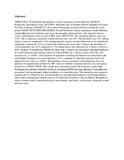| dc.contributor.author | Koigi-Kamau, R | |
| dc.contributor.author | Kabare, LW | |
| dc.contributor.author | Wanyoike-Gichuhi, J | |
| dc.date.accessioned | 2013-06-13T07:10:04Z | |
| dc.date.available | 2013-06-13T07:10:04Z | |
| dc.date.issued | 2005 | |
| dc.identifier.citation | East Afr Med J. 2005 Jul;82(7):357-61. | en |
| dc.identifier.uri | http://www.ncbi.nlm.nih.gov/pubmed/16167709 | |
| dc.identifier.uri | http://erepository.uonbi.ac.ke:8080/xmlui/handle/123456789/32701 | |
| dc.description.abstract | OBJECTIVE:
To determine the incidence of post-caesarean wound infection.
DESIGN:
Prospective descriptive study.
SETTING:
Maternity unit of Kiambu District Hospital in Central Province of Kenya.
SUBJECTS:
All women undergoing caesarean delivery during the study period.
MAIN OUTCOME MEASURES:
Overall incidence of post-caesarean wound infection, relationship between incidence and socio-demographic characteristics, pre-operative labour events, intrapartum events as well as HIV status.
RESULTS:
The caesarean delivery rate was 7.8%. The overall post-caesarean wound infection rate was 19%. The incidence was 32% among single women as compared to 16% among married women, but this difference is not statistically significant. Among the 35% of women who laboured for more than 12 hours, the incidence of wound infection was 33% compared to 15% among those who laboured for 12 hours or less (p < 0.01). Rupture of membranes (ROM) for more than 12 hours was associated with high incidence of wound infection than among women in whom ROM was 12 hours or less (38% and 14% respectively, p < 0.001). Also duration of operation exceeding 60 minutes was associated with much higher incidence of wound infection (71%) compared to when the operation lasted 60 minutes or less (16%, p < 0.001). The incidence of post-caesarean wound infection does not appear to be significantly affected by HIV status or whether caesarean delivery was emergency or elective.
CONCLUSION:
The overall post-caesarean wound infection rate is quite high. Prolonged pre-operative duration of labour, prolonged ROM and long duration of operation are associated with significantly higher incidence of wound infection. This should be seen against a background of a relatively low caesarean delivery rate and high incidence of prolonged labour. Strict labour management policies need to be inculcated in labour wards in District Hospitals in order to ensure timely caesarean delivery interventions, and hence, reduce post-caesarean wound infection rates. | en |
| dc.language.iso | en | en |
| dc.title | Incidence of wound infection after caesarean delivery in a district hospital in central Kenya. | en |
| dc.type | Article | en |
| local.publisher | Department of Obstetrics and Gynaecology, College of Health Sciences, University of Nairobi, | en |

